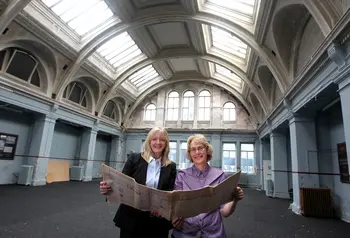Making our past relevant to our future - How industrial heritage can boost growth

The Prince's Regeneration Trust, Heritage Lottery Fund and Historic England are together hosting the conference - Reviving Places By Reusing Industrial Heritage - on the 1-2 December at Manchester's Museum of Science & Industry (MOSI).
Speakers will include
- Sir Howard Bernstein, Chief Executive, Manchester City Council
- Tom Walker, Director of Cities & Local Growth Unit, DCLG/BIS/Cabinet Office
- Jonathan Robinson, The Guardian
- Rohan Silva former Number 10 Special Adviser and Co-Founder, Second Home
- Duncan Wilson OBE, Chief Executive, Historic England
- Carole Souter CBE, Chief Executive, Heritage Lottery Fund
- Ros Kerslake, Chief Executive, The Prince’s Regeneration Trust
- Tom Bloxham MBE, Chairman and Co-Founder, Urban Splash
- Sally MacDonald, Director, MOSI
Rowan Moore, the Observer’s architecture critic, is chairing a debate.
The conference follows the Council of Europe’s declaration of 2015 as European Industrial & Technical Heritage Year.
The central theme is the re-use of vacant and at-risk industrial heritage buildings, such as former warehouses and factories. A particular focus is how such buildings are suitable for use by the creative industries - an important growth sector in the UK. The conference aims to offer local authorities, developers, investors, community-led and not-for-profit organisations helpful advice and guidance from leading figures in the sector.
A survey by Historic England (formerly known as English Heritage) in 2011 found that the percentage of Grade I and II* listed industrial buildings at risk (nearly 11%) was three times greater than the national average for Grade I and II* listed buildings at risk in England (3%). The conference will make it clear that the re-use of these types of buildings has the potential to act as a major catalyst for local economic regeneration.
Ros Kerslake, Chief Executive of The Prince’s Regeneration Trust, said: "We need to reverse the neglect and abandonment of our industrial buildings because it is not just a terrible waste of resources, but also a missed opportunity.
“With the public, private and charitable sectors working together, we have the stimulus to revive these buildings into active, relevant and engaging spaces once again. By doing so, we create better places to work, new jobs, increased economic activity, and of course, we restore peoples' sense of pride and purpose."
Duncan Wilson, Chief Executive of Historic England, said: “I can’t think of a better place to celebrate industrial heritage than Manchester. Britain was the world’s first industrial nation and the legacy of this is all around us. It is very encouraging that new uses have been found for important industrial buildings such as Grade II* Paragon Mill in Manchester which has been converted to apartments, the north warehouse at Stanley Dock in Liverpool, now a fantastic hotel; and Battersea Power Station which will be the centre-piece of a large redevelopment.
“But there are a great many more industrial buildings whose future is much less certain. Our industrial heritage offers huge potential for significant economic growth but finding viable new uses for these buildings can be difficult and this conference will help us identify creative and imaginative solutions.”
Carole Souter, Chief Executive of HLF, said: “Historic industrial buildings have always helped define places. That hasn’t always been seen positively. But now they are once again spearheading economic success - from the former North British Rubber Company’s HQ in Edinburgh, to Harvey’s Foundry in Cornwall and many more in between. When we tap into what makes these buildings distinctive, they can regenerate towns and cities, generate jobs for local people, and create positive new identities.”
Revived and re-used industrial buildings can be distinct, adaptable, spaces crucial to stimulating new industries. Creative companies and start-ups often seek premises near like-minded businesses in mixed-use, flexible spaces which can offer attractively-low rents. London’s Shoreditch and Manchester’s Northern Quarter are good examples of this. Industrial buildings can also be successfully converted to residential use.
Industrial heritage can provide a return on investment for the private sector but the conference will make it clear that it is not just business that benefits. It can also offer local authorities an opportunity to revive their towns and cities, encouraging new investment and growth and restoring local pride. A viable new solution also removes the long-term maintenance and repair costs of looking after a vacant and decaying building.
Cities, regions and communities are able to benefit from the social and economic opportunities derived from regeneration and re-use. Community groups attending the conference will gain knowledge about how they can save cherished local industrial heritage buildings that once gave their city or town a sense of place and identity. They will gain valuable advice from experts on the necessary skills and expertise needed to ensure a successful outcome for their local building, including business planning advice, securing private investment, and engaging with the wider community.
The conference offers expert guidance by leading figures from the regeneration, heritage and architecture sectors as well as influential voices at the top of central and local government. The programme is full of practical examples, examining a number of regeneration projects, including the successful revival of Middleport Pottery in Stoke-on-Trent and the planned restoration of the derelict Ancoats Dispensary in Manchester.
The Museum of Science and Industry (MOSI), is an appropriate venue for the conference since it is housed in the former Liverpool Road Station, one of Manchester’s most important and historic sites.
The conference will be split into two days, each with a slightly different focus:
- Day one will explore the role of the public sector in encouraging the creative reuse of industrial heritage and commercial opportunities as well as exploring the challenges presented by historic industrial buildings. The focus will be on creative industries, development and regeneration uses. It aims to connect with businesses, investors and local/national decision makers.
- Day two will explore opportunities to develop new uses and engage with commercial partners to leverage investment and funding with a focus on not-for-profit groups, community organisations, heritage sector partners and historic building owners.
One- and two-day conference tickets are available. Tickets can be booked at the Industrial Heritage Conference 2015 website or by calling 020 3262 0560 (during office hours).
Notes to editors
Case Study: Toffee Factory, Newcastle
The Toffee Factory sits within the Ouseburn Valley area of Newcastle near the Quayside. With buddleia having taken over the brickwork and the roof collapsed inwards, the former sweet factory was a challenging site. However, the building has been cleverly converted to start-up units using a contemporary design and innovative additions to the building. Now managed by Creative Space Management, it is an example of what can be done with a really imaginative approach to reuse. The Royal Institute of British Architects (RIBA) recognised the architectural excellence of the redevelopment of the Toffee Factory in 2012 with three awards. More details are available at the Toffee Factory website.
Case study: Middleport Pottery
Middleport Pottery is one of the oldest working Victorian potteries in the UK, and the home of world-famous Burleigh pottery. The Grade II* listed Pottery was almost lost forever through disrepair, but in 2011 The Prince's Regeneration Trust began to put together a £9million funding package to buy and fully restore it. The Prince's Regeneration Trust has leased approximately half the site back to Burgess & Leigh Ltd, so Burleigh pottery is still made there, just as it has been since 1888, and local jobs have been saved. Empty parts of the site have been adapted as workspaces and leased to craft businesses to make the site a centre of local creativity. There is also a visitor centre showing the history and restoration of the site, a café, and tours of the Burleigh factory. Since it opened in July 2014, the Pottery has won eight awards, including a 2015 RIBA National Award and a Europa Nostra Award. For more details, go to the Middle Pottery website, or the Middle Pottery Facebook page.
Case study: Harland and Wolff Drawing Offices, Belfast
The Harland and Wolff Headquarters Building and Drawing Offices on Queen’s Island, Belfast were the control centre for the largest shipyard in the world. It was here that Belfast workers created and designed over 1,000 ships including the White Star Olympic Class Liners – Olympic, Titanic and Britannic and naval warships such as HMS Belfast. Yet, following the closure of the shipyard, the site has been largely vacant since 1989 and considered ‘at risk’ for almost a decade.
Now, thanks to a £4.9million grant from the Heritage Lottery Fund (HLF) the derelict Harland and Wolff Drawing Offices will be transformed into an 84-bedroom boutique hotel, with the potential to create over 100 local jobs. The hotel complex will also tell the story of Belfast’s industrial heritage, focusing on the authentic spaces – such as the Board Room, Telephony Room and Entrance Lobby – as well as the fixtures and fittings that relate to the local shipbuilding industry.
The grant has been awarded through HLF’s Heritage Enterprise programme. It is designed to help when the cost of repairing an historic building is so high that restoration simply is not commercially viable. Grants of £100k to £5million bridge the financial gap, funding the vital repairs and conservation work needed to convert derelict, vacant buildings into new, usable commercial spaces that can have a positive impact on local economies. More information is available on the Heritage Enterpirse programme page.
About The Prince’s Regeneration Trust
The Prince’s Regeneration Trust (PRT) is a world-leading regeneration charity working in hard-hit areas of the UK to rescue and re-use local buildings in order to transform lives. Over the past 19 years, they have worked on projects saving about 1.4million square feet of buildings - enough to fill almost 32 football pitches - and have created about 1,800 jobs. Find out more about PRT today by going to the Prince's Regeneration Trust website, the Prince's Regeneration Trust Facebook page, or follow them on Twitter: @PrincesRegen.
About Historic England
Historic England (formerly known as English Heritage) is the public body that champions and protects England's historic places. They look after the historic environment, providing expert advice, helping people protect and care for it and helping the public to understand and enjoy it.
Further information
For interviews with Ros Kerslake, Chief Executive of The Prince’s Regeneration Trust, and for further information and pictures, contact:
- John Geoghegan, Communications, The Prince's Regeneration Trust on 020 3262 0562, email: john.geoghegan@princes-regeneration.org
- Marcus Stanton, Communications, The Prince's Regeneration Trust. on 020 8617 0210, mobile: 07900 891 287, email: marcus@marcusstanton.co.uk
For interviews with Duncan Wilson, Chief Executive of Historic England and for further information, please contact:
- Debbie Hickman, Communications, Historic England on 020 7973 3855, email: Debbie.hickman@historicengland.org.uk
For interviews with Carole Souter, Chief Executive of the Heritage Lottery Fund and for further information, please contact:
- Natasha Ley, Senior Media and Government Relations Manager, Heritage Lottery Fund on 020 7591 6143, mobile: 07973 402 854, email: natashal@hlf.org.uk.

